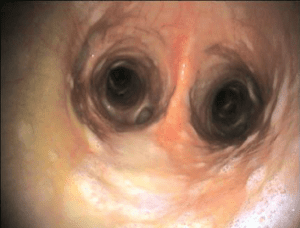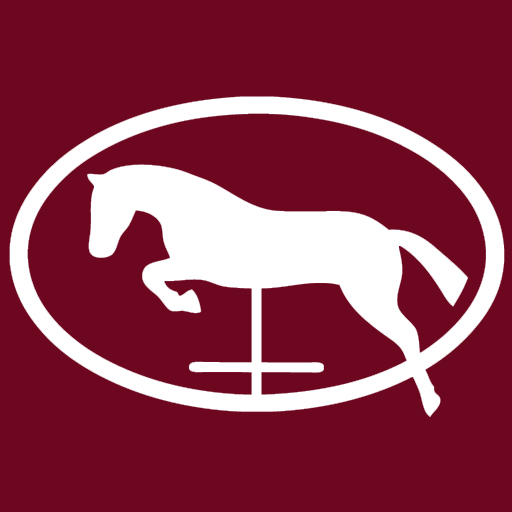#AskTheVet with Dr. Aja Harvey
Question: What are heaves? How is it diagnosed and what are some treatment or management strategies that are used to prevent recurrence?
Answer:
“Heaves” is the layman’s term used commonly to refer to the chronic, non-infectious lung inflammation some horses develop in response to exposure to environmental allergens.
The more current terminology employed by veterinarians is Equine Asthma, which includes two distinct disease syndromes: Inflammatory Airway Disease (IAD) and Recurrent Airway Obstruction (RAO). RAO is the disease condition that the term heaves is usually referring to, and occurs most commonly in middle aged to older horses.

Much like the asthma that humans experience, recurrent airway obstruction is a result of the lung’s hypersensitivity response (bronchoconstriction, airway inflammation) secondary to certain antigens or allergens in the horse’s environment. Also much like humans, horses have varying degrees of clinical signs. Mildly affected animals can have increased nasal discharge, a noticeable dry cough at rest or even slight exercise intolerance in the absence of any respiratory signs. In more severe cases, a sudden flare up will have the horse struggling to breathe at rest – with a noticeable nostril flare, constant cough, wheezing and marked weight loss. The time that these horses spend breathing out is usually quite prolonged, and as a result they often develop hypertrophied external abdominal muscles, which form a prominent profile that is referred to as a “heave line”. In the Northeastern part of the United States, RAO flares are associated with increased stabling in the winter, however, severely affected animals and those that live in the South tend to have episodes of respiratory distress during the late spring and summer months when the environmental pollen levels tend to be much higher.
muscles, which form a prominent profile that is referred to as a “heave line”. In the Northeastern part of the United States, RAO flares are associated with increased stabling in the winter, however, severely affected animals and those that live in the South tend to have episodes of respiratory distress during the late spring and summer months when the environmental pollen levels tend to be much higher.
In order to definitively diagnose a horse with either form of equine asthma, a sample of fluid from the lower airway is obtained by performing a lung wash, otherwise known as a bronchoalveolar lavage or BAL. The fluid is analyzed under a microscope to see if there is an increase in specific inflammatory cells (such as neutrophils, eosinophils or mast cells) and/or mucous, which contribute to a cascade of events that initiate and prolong airway hyperreactivity. 
In terms of treatment, I stress to owners that although the medications (corticosteroids and/or bronchodilators) we often prescribe to horses suffering from acute flares help immediately to control airway inflammation and can make a horse more comfortable in a matter of hours; near complete resolution and reduction of clinical signs relies on implementation of strict environmental management strategies. This a list of some of the strategies that I recommend owner’s implement in order to reduce the amount of allergen load in the environment:
- Thoroughly soaking or steaming hay
- Avoid the use of round bales
- Switch to pelleted hay formulations
- Increase turnout
- Increase ventilation in the barn (use fans, open windows and doors)
- Use low dust bedding (cardboard, sawdust commercial bedding – avoiding straw)
- Remove affected horses from the barn when cleaning stalls
Once a horse develops RAO, they will always be susceptible to developing sudden episodes of respiratory distress when exposed to even small amounts of particles that irritate them. The good news is that veterinarians have developed consistent and well established treatment and management protocols that can help affected animals live comfortably and perform up to expectations.
If you have any additional questions about equine asthma, or any other issues regarding your horse’s health, feel free to contact B.W. Furlong & Associates to speak with a clinician on our internal medicine team!
Photo Credit and Information:
Niedźwiedź, Artur. (2014). Equine Recurrent Airway Obstruction. Macedonian Veterinary Review. 37. 115-120. 10.14432/j.macvetrev.2014.08.019.
Figure 1: The bronchoconstriction with large amount of mucus accumulated in the bronchi as a result of goblet cells hyperplasia
Figure 2: Hypertrophy of the external abdominal oblique muscle which manifests itself as a so-called “heave line”
Figure 3: Nostril dilatation and mucosal nasal discharge in RAO
Recent Posts
About Us
At B.W. Furlong & Associates, we are progressive leaders delivering the ultimate in veterinary care to our equine patients and clients in both the hospital and ambulatory setting. We have several associated practices offering exemplary care and services in New Jersey, Florida, and Virginia
